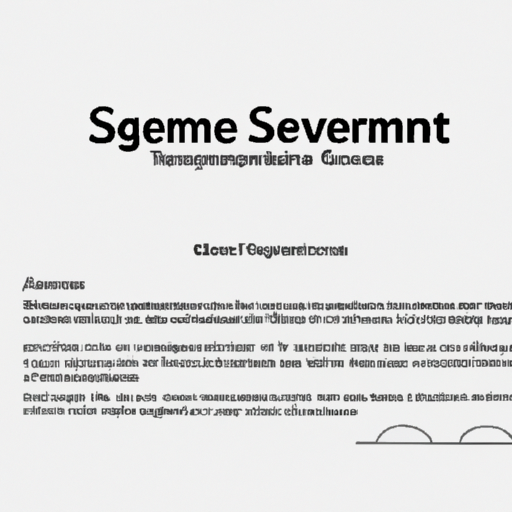Title: Breaking Down Severance Agreement Templates: A Comprehensive Guide for Employers and Employees
Introduction:
In today’s ever-evolving employment landscape, the need for clear and concise severance agreements has become paramount for both employers and employees. A severance agreement, also known as a separation or termination agreement, outlines the terms and conditions under which an employment relationship ends. As legal frameworks surrounding severance continue to evolve, having a well-structured and legally sound severance agreement template can prove invaluable to protect the rights and interests of all parties involved.
This article aims to provide a comprehensive overview of severance agreement templates, exploring their significance, key components, and factors to consider while drafting or negotiating such agreements. Whether you are an employer seeking to protect your business interests or an employee navigating the complexities of separation, understanding the fundamentals of severance agreements and their template variants is vital to ensuring a fair and mutually beneficial transition.
Understanding the nuances of severance agreements can be a daunting task, as each situation is unique and necessitates a customized approach. Nevertheless, by acquainting yourself with the fundamentals surrounding severance agreements and harnessing the power of templates tailored to meet different needs, you can foster transparency, minimize disputes, and facilitate an amicable separation process.
Throughout this article, we will delve into the key sections typically found within a severance agreement template, highlighting their overarching purpose and offering insights into common negotiating points for both parties. Moreover, we will explore essential considerations such as statutory requirements, confidentiality clauses, non-compete provisions, and other crucial aspects that can significantly impact the effectiveness and enforceability of any severance agreement.
By equipping yourself with the knowledge encapsulated within this article, you will be better positioned to navigate the intricacies of severance agreements, safeguard your rights, and make informed decisions that align with your specific circumstances.
Note: This article aims to provide a general understanding of severance agreement templates and should not be construed as legal advice. Any specific legal questions or concerns should be addressed to qualified legal professionals experienced in employment law.
Table of Contents
- Overview of Severance Agreement Templates
- Key Components to include in a Severance Agreement
- Understanding the Legal Requirements for Severance Agreements
- Ensuring Clarity and Precision in Severance Agreement Language
- Addressing Termination Terms and Conditions in a Severance Agreement
- Protection of Employer’s Interests in a Severance Agreement
- Best Practices for Negotiating a Severance Agreement
- Common Mistakes to Avoid in Drafting a Severance Agreement
- Key Takeaways

Overview of Severance Agreement Templates
Severance agreements are essential legal documents that outline the terms and conditions under which an employee will be provided with compensation and benefits upon termination of their employment. To simplify the process, many organizations rely on severance agreement templates. These templates serve as pre-designed documents that can be customized to suit individual situations, ensuring a fair and consistent approach when it comes to severance packages.
Severance agreement templates typically include various sections and provisions that cover important aspects of the agreement. These may encompass details such as the reason for termination, the amount of severance pay, the duration of continued health insurance coverage, confidentiality obligations, and the release of any potential legal claims against the employer. Using a template can save time and effort for both employers and employees, as it provides a structured framework that can be adapted to match the specific circumstances of any given employment termination.

Key Components to include in a Severance Agreement
When preparing a severance agreement, it is crucial to include key components that protect the interests of both parties involved. In order to create a comprehensive severance agreement template, there are several important elements that should be included:
1. Severance Benefits: Clearly outline the compensation and benefits the employee will receive upon termination. This may include severance pay, continuation of benefits, and any other financial compensation agreed upon.
2. Release of Claims: Include language that ensures the employee waives their right to pursue legal action or claim damages against the employer. This helps to protect the employer from future disputes or lawsuits.
3. Non-Disclosure and Confidentiality: Clearly define what information is considered confidential and prohibit the employee from sharing or divulging such information. This protects the company’s trade secrets, intellectual property, and sensitive data.
4. Non-Compete and Non-Solicitation: Specify if the employee is restricted from working for a competitor or soliciting clients or employees of the company, and the duration of this restriction.
5. Return of Company Property: Clearly state that all company property, including but not limited to laptops, phones, keys, and confidential documents, must be returned to the employer upon termination.
By including these key components in a severance agreement, both the employer and employee can have clarity and protection in the event of a termination. It is important to consult with legal professionals to ensure the severance agreement is compliant with local laws and regulations.
Understanding the Legal Requirements for Severance Agreements
Severance agreements play a crucial role in safeguarding the interests of both employers and employees during the process of separation. However, to ensure compliance with legal requirements, it is essential to have a clear understanding of the terms and conditions that govern these agreements. Here, we provide you with a comprehensive guide on , helping you navigate through the complexities of this crucial document.
1. **Consideration:** A severance agreement must outline the consideration offered by the employer in exchange for the employee’s agreement to release any claims against the company. This consideration can take various forms, such as a lump sum payment, continued healthcare benefits, or even career counseling services.
2. **Confidentiality and Non-Disclosure:** To preserve sensitive company information, severance agreements often include a confidentiality clause, prohibiting the employee from discussing any details of their employment, termination, or severance package. Additionally, non-disclosure provisions may extend beyond company information, preventing the employee from divulging trade secrets or participating in any activities that may harm the employer’s reputation.
3. **Non-Disparagement:** It is common for severance agreements to include a non-disparagement clause, where both the employer and the employee agree not to make negative or harmful comments about each other. This provision helps maintain a positive public image while also protecting the employee from potential damage to future employment prospects.
4. **Waiver of Rights:** Severance agreements typically include a section where the employee voluntarily waives their right to file any claims against the employer, including claims based on employment discrimination, harassment, or breach of contract.
is crucial to ensure that both parties are protected in the event of a separation. By addressing key elements such as consideration, confidentiality, non-disparagement, and waiver of rights, employers can create a comprehensive severance agreement that complies with necessary legal standards, fostering a fair and respectful transition for all parties involved.
Ensuring Clarity and Precision in Severance Agreement Language
When it comes to drafting a severance agreement, it is imperative to ensure that the language used is clear and precise. Clarity not only helps to avoid potential misinterpretations but also ensures that all parties involved have a comprehensive understanding of the terms and conditions. By using a well-crafted severance agreement template, you can streamline the process and establish an effective framework for any employment termination.
To achieve clarity and precision in severance agreement language, consider the following:
- Define key terms: Clearly define terms such as “severance pay,” “confidentiality,” and “non-compete agreement” to avoid confusion and provide a clear understanding of expectations.
- Use simple language: Avoid jargon, complex legal terms, and convoluted sentences. Instead, opt for plain and straightforward language that can be easily understood by all parties.
- Break it down into sections: Organize the agreement into logical sections, each focusing on a specific aspect such as severance benefits, post-employment obligations, or dispute resolution. This approach enhances readability and comprehension.
Incorporating these practices into your severance agreement language can greatly reduce ambiguity and mitigate the risk of future disagreements. By using a reliable and clear-cut template, you can ensure that your severance agreements are thorough, legally sound, and provide a solid foundation for the termination process.
Addressing Termination Terms and Conditions in a Severance Agreement
An integral component of any severance agreement is the careful consideration of termination terms and conditions. As an employer or an employee, it is crucial to comprehend these aspects to effectively navigate the agreement. By addressing termination terms in a severance agreement, you can establish clarity, protect your rights, and ensure a smooth transition.
Key points to address in termination terms and conditions:
- Notice Period: Clearly outline the required notice period that either party must adhere to before terminating the agreement. This allows for advance planning and minimizes disruptions in business operations or securing new employment.
- Reasons for Termination: Specify the circumstances under which termination can occur, such as poor performance, breach of contract, or voluntary resignation, to ensure both parties understand the conditions that could lead to the end of the employment relationship.
- Severance Pay: Clearly state the amount, structure, and timing of any severance pay that may be provided. This provides security for employees and allows employers to manage the financial impact of termination in a fair and consistent manner.
- Non-Compete and Non-Solicitation Clauses: Consider including clauses that restrict the employee from working for or soliciting clients or employees from competitors for a specified period. This safeguards confidential information, trade secrets, and an employer’s legitimate business interests.
- Confidentiality Obligations: Define the obligations of both parties in terms of maintaining the confidentiality of proprietary information or intellectual property after termination. This ensures the protection of sensitive business data and customer relationships.
Protection of Employer’s Interests in a Severance Agreement
When drafting a severance agreement, it is crucial to prioritize the protection of the employer’s interests. By clearly outlining the terms and conditions that safeguard the employer’s rights and assets, both parties can enter into the agreement with a sense of security and mutual understanding. Here are some key considerations to keep in mind:
- Confidentiality: Confidential information is the lifeblood of any business. To safeguard the employer’s proprietary knowledge, trade secrets, and client information, it is essential to include strict confidentiality provisions in the severance agreement. This clause should specify the types of information covered, the duration of confidentiality obligations, and potential consequences for breaches.
- Non-Competition: To avoid any potential harm to the employer’s business, a non-competition clause can restrict the departing employee from working for competitors or engaging in any activities that could negatively impact the employer. It is advisable to clearly define the prohibited activities, geographical limitations, and duration of the non-competition period.
- Non-Solicitation: Protecting the employer’s relationships with its clients, suppliers, and employees is crucial. Including a non-solicitation clause in the severance agreement restricts the departing employee from enticing or soliciting these individuals to work with or for them in their new endeavors.
By incorporating these protections into a comprehensive severance agreement, employers can safeguard their interests and preserve their business’s competitive advantage. It is essential to seek legal counsel to tailor these provisions to the specific needs and circumstances of the employer.
Best Practices for Negotiating a Severance Agreement
When negotiating a severance agreement, it is crucial to be well-prepared and fully aware of the best practices to ensure you secure the most favorable outcome. Here are some key tips to keep in mind:
1. Gather Information: Before entering into negotiations, thoroughly research your employee rights and the legal provisions surrounding severance agreements. Understanding the standard practices in your industry will empower you during the negotiation process.
2. Assess Your Strengths and Weaknesses: Take stock of your unique circumstances, such as your tenure, skills, and performance track record, and evaluate how these factors could influence your bargaining position. Identifying potential areas of leverage will enable you to advocate for a more advantageous severance package.
3. Maintain Professionalism and Confidentiality: Throughout negotiations, it is crucial to remain calm, composed, and diplomatic. Avoid discussing sensitive details or divulging confidential information that may harm your chances of reaching a mutually beneficial agreement.
4. Seek Legal Advice: Consulting an attorney who specializes in employment law is highly recommended. They can provide invaluable guidance, review the terms of the agreement, and ensure that your rights are protected.
5. Understand the Terms: Familiarize yourself with the various components of a severance agreement, such as monetary compensation, continued healthcare benefits, and non-compete clauses. Analyze each provision carefully and determine their importance to negotiate effectively.
6. Identify Possible Negotiation Points: Consider aspects of the agreement that may be open to negotiation, such as the duration of healthcare coverage, the inclusion of a non-disparagement clause, or the opportunity for rehire. Prioritize your goals and be prepared to make compromises, if necessary.
7. Document Everything: Keep a comprehensive record of all communications, including emails, letters, or notes from meetings. These documents will serve as evidence and help protect your interests in case of any disputes that may arise later on.
8. Take Time to Review: It is essential to carefully review the final severance agreement before signing it. If you have any concerns or questions, seek clarification and make any necessary changes before committing to the contract.
Common Mistakes to Avoid in Drafting a Severance Agreement
When drafting a severance agreement, it is crucial to avoid common mistakes that can have significant legal and financial implications. By understanding these pitfalls and taking precautions, you can ensure that your severance agreement is thorough, enforceable, and protects both parties involved. Below are some of the most common mistakes to avoid when creating a severance agreement:
- Failing to consult with legal counsel: One of the biggest mistakes individuals make when drafting a severance agreement is not seeking legal advice. Each situation is unique, and an employment attorney can provide valuable guidance to ensure that all legal requirements are met and that your rights are protected.
- Neglecting to include specific and detailed terms: It is essential to include clear and specific terms in the severance agreement to avoid any misunderstandings or disputes. The document should clearly outline the amount of severance pay, any additional benefits, the date of termination, non-competition clauses, and any other relevant provisions that are specific to the circumstances.
Avoiding these common mistakes can go a long way in ensuring that your severance agreement is fair, legally sound, and protects both parties involved. Remember that it is always wise to consult with an experienced employment attorney to help navigate the complexities of drafting a severance agreement.
Key Takeaways
In conclusion, a well-crafted severance agreement template serves as an indispensable tool for both employers and employees in navigating the complexities of the termination process. By providing a comprehensive framework that outlines the rights, obligations, and benefits of both parties, a properly executed severance agreement can safeguard the interests of all involved. Its ability to clarify expectations, protect sensitive information, and mitigate potential legal risks underscores its value in promoting a fair and amicable separation. While the specific terms and conditions may vary based on individual circumstances and jurisdictional requirements, the underlying principles of fairness, transparency, and mutual understanding remain universal. Therefore, utilizing a carefully tailored severance agreement template not only ensures compliance with legal standards, but also fosters an environment of professionalism and respect during a time of transition. Ultimately, by leveraging this invaluable resource, both employers and employees can expertly navigate the challenging terrain of severance agreements, thus setting the stage for a smoother and more secure separation.
